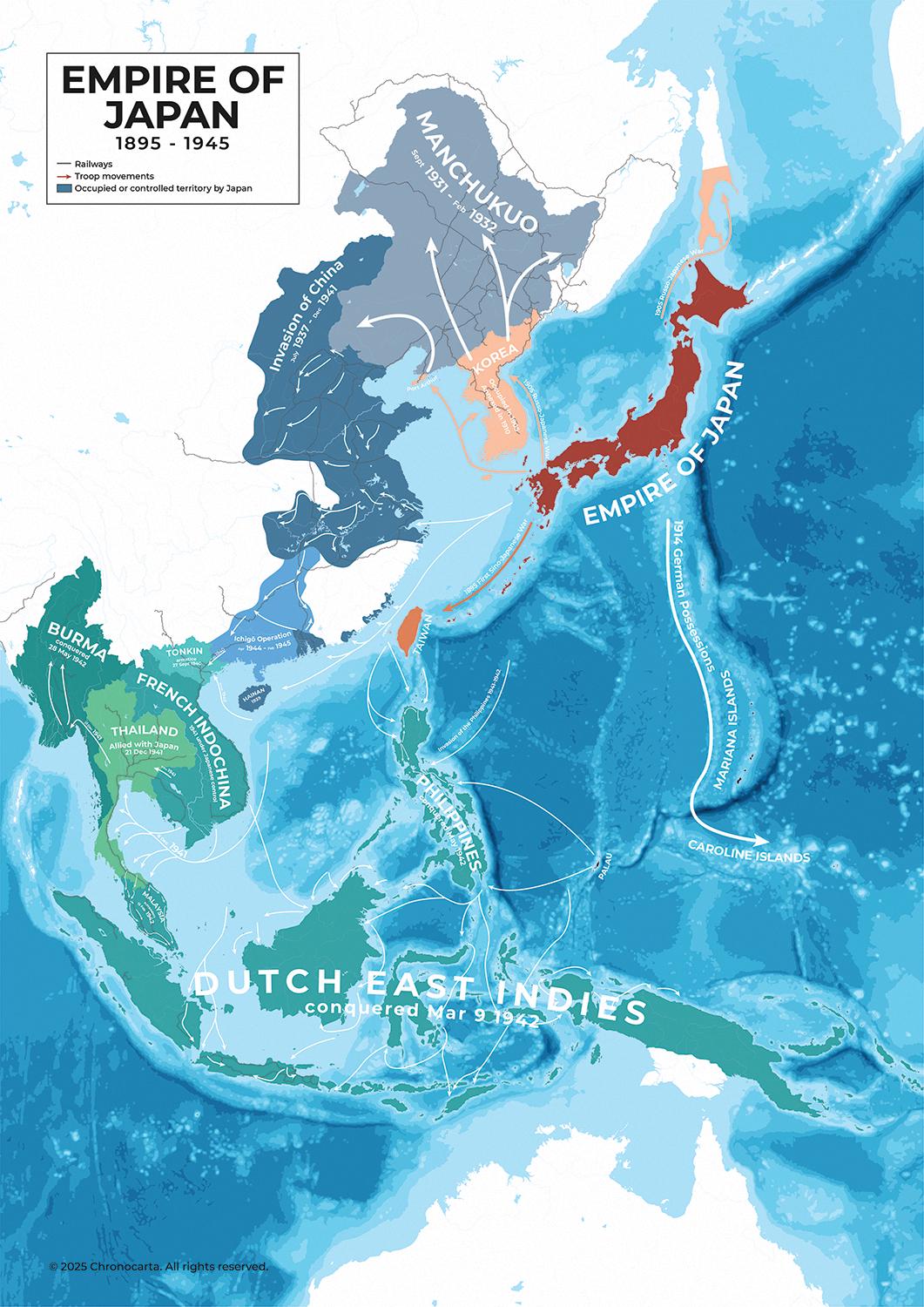Map of the Empire of Japan 1895-1945


David Chen
Data Visualization Specialist
David Chen is an expert in transforming complex geographic datasets into compelling visual narratives. He combines his background in computer science ...
Geographic Analysis
What This Map Shows
This map displays the territorial extent of the Empire of Japan between the years 1895 and 1945, capturing a significant period marked by Japan's rapid expansion and militarization. This era began with Japan's victory in the First Sino-Japanese War in 1895 and culminated in the aftermath of World War II. Covering various regions across Asia and the Pacific, the map highlights Japan's imperial ambitions, illustrating the areas under its control as well as the territories it sought to dominate.
Deep Dive into the Empire of Japan
The Empire of Japan was a state characterized by its aggressive expansionist policies during the late 19th and early 20th centuries, which were fueled by a desire to become a major world power. The process began with the Meiji Restoration in 1868, which led to a series of reforms aimed at modernizing Japan's military, economy, and society, effectively transforming it from a feudal society into an industrialized nation.
What’s fascinating is that Japan's imperialism was largely driven by competition with Western powers. By the late 19th century, Japan had successfully established itself as a formidable force with military victories over China and Russia. The First Sino-Japanese War (1894-1895) allowed Japan to gain Taiwan and influence over Korea, which was formally annexed in 1910. This marked Japan's first significant territorial acquisition, illustrating its burgeoning ambitions and capabilities.
However, the map also delineates Japan's expansion into Southeast Asia and the Pacific during World War II, particularly after the attack on Pearl Harbor in 1941. Territories such as the Philippines, parts of Indonesia, and various Pacific islands came under Japanese control, showcasing the scale of its military campaigns. By the height of its expansion, the Empire of Japan covered over 1.5 million square miles, making it one of the largest empires in history. Interestingly, the cultural impact of Japanese imperial rule in these regions was profound, affecting local governance, society, and economies.
Regional Analysis
Focusing on specific regions, the map highlights several key areas of Japanese influence. In East Asia, the annexation of Korea and Taiwan was pivotal, as Japan sought to integrate these territories into its national framework. In Korea, for instance, Japanese rule led to significant cultural assimilation efforts and infrastructure development, but it was also marked by severe oppression and resistance.
In Southeast Asia, the invasion of the Philippines in 1942 was characterized by brutal military campaigns and attempts to establish a Greater East Asia Co-Prosperity Sphere, which was often more about resource extraction than genuine cooperation. The Philippines, rich in natural resources, became a critical area for Japan's war efforts. The map also illustrates Japan's strategic interests in places like Indochina, which provided crucial supply routes during the war.
However, in contrast to the relatively quick military successes in these regions, the Japanese faced staunch resistance in areas like China, where the Second Sino-Japanese War (1937-1945) resulted in prolonged conflict and significant casualties. The map encapsulates these territorial struggles, emphasizing the uneven nature of Japanese imperial expansion.
Significance and Impact
Understanding the Empire of Japan and its territorial ambitions is crucial not only for grasping the historical context of World War II but also for comprehending modern East Asian geopolitics. The legacy of Japanese imperialism continues to influence relations in the region today, with lingering tensions over historical grievances, territorial disputes, and differing perspectives on wartime actions.
Moreover, as we look to the future, the rise of nationalism in various countries that were once under Japanese rule raises questions about how history shapes contemporary identities and international relations. The map serves as a reminder of the complex tapestry of power dynamics that have defined East Asia and the Pacific, highlighting the importance of historical awareness in navigating current geopolitical challenges.
In conclusion, the Empire of Japan's map from 1895 to 1945 is more than just a representation of territorial conquests; it encapsulates a pivotal chapter in global history that continues to resonate today. Ever wondered how these historical events have shaped the modern geopolitical landscape? Exploring this question can provide valuable insights into Japan's role in global affairs and its relationships with its neighbors.
Visualization Details
- Published
- October 21, 2025
- Views
- 24
Comments
Loading comments...